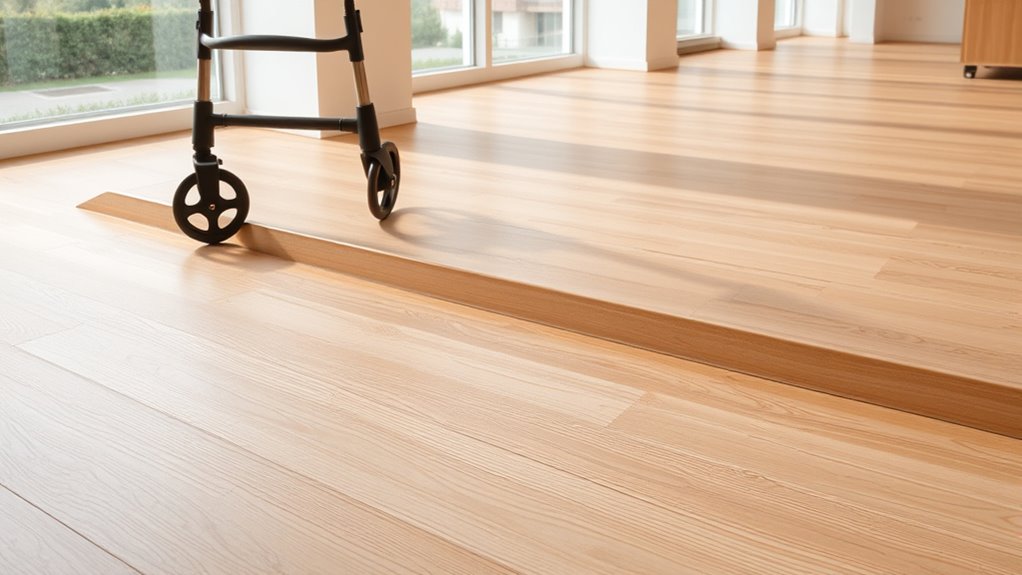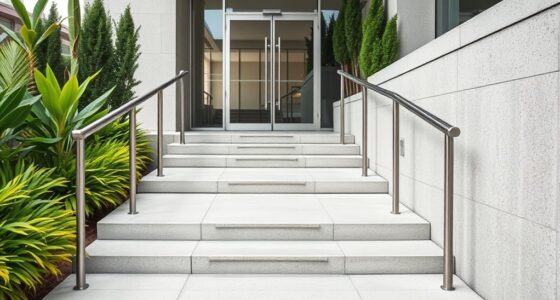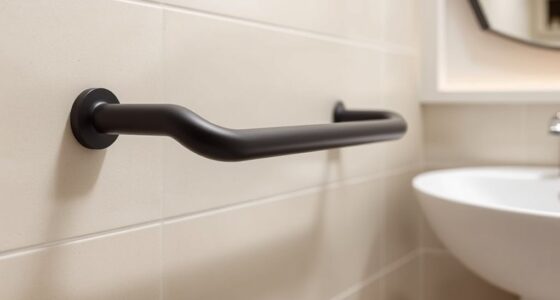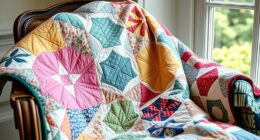To guarantee safe flooring for wheelchairs and walkers, choose surfaces that provide good traction such as low-pile carpet, vinyl, or hardwood, and avoid slippery, glossy floors. Incorporate ramps for changes over steps or thresholds, making certain they’re sturdy with non-slip surfaces and gentle slopes. Keep pathways clear of clutter and regularly inspect flooring and ramps for damage. Continuing will reveal simple modifications that can greatly improve safety and accessibility in your space.
Key Takeaways
- Choose low-pile, firm flooring like vinyl, laminate, or hardwood for easy mobility and reduced resistance.
- Install ramps with gentle slopes and non-slip surfaces at doorways and level changes for safe transitions.
- Ensure flooring has good traction by avoiding smooth, glossy surfaces and adding textured mats where needed.
- Securely fix threshold ramps and beveled edges to prevent shifting and improve wheelchair and walker access.
- Regularly inspect and maintain flooring and ramps to identify damage or wear, ensuring continuous safety.
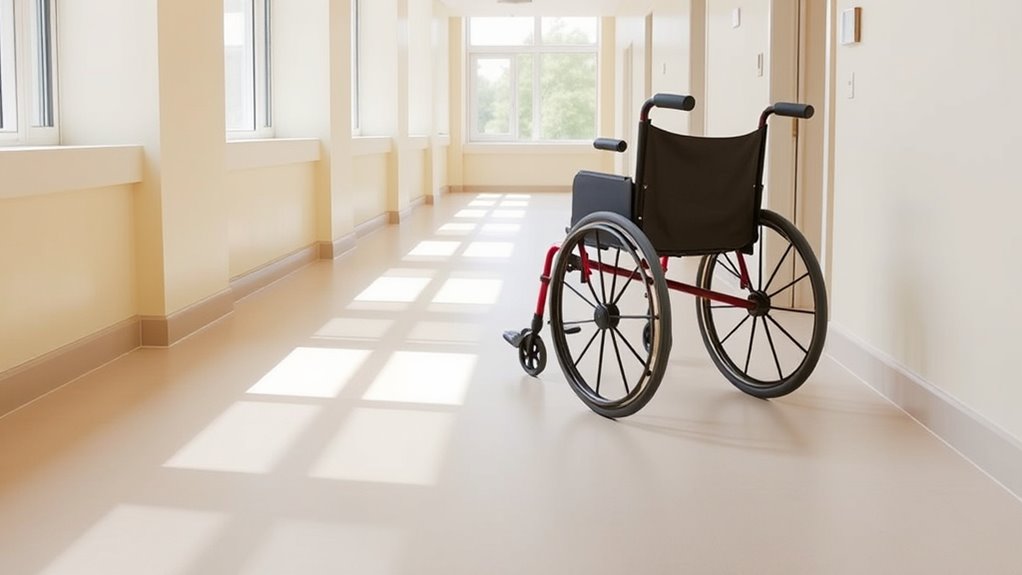
Choosing the right flooring is essential for creating a safe and secure environment, whether at home or in the workplace. When it comes to mobility devices like wheelchairs and walkers, your flooring can make all the difference in preventing accidents and ensuring ease of movement. One key aspect to consider is ramp installation, which can substantially improve accessibility. Properly installed ramps, including threshold ramps, help bridge height differences between rooms or entryways, making transitions smoother and safer. Threshold ramps are especially useful at doorways, where a small step or height difference could pose a challenge or a hazard for wheelchair users or those with walkers.
When selecting flooring, look for surfaces that provide good traction to prevent slips and falls. Smooth, glossy floors might look appealing but can be slippery, especially when wet. Textured surfaces or mats help improve grip and stability. Additionally, contemplating the height and firmness of your flooring is important. Softer carpets or rugs can sometimes be a trip hazard or make rolling a wheelchair more difficult, so opt for low-pile carpets or smooth, firm flooring like vinyl, laminate, or hardwood that allows for easy movement and reduces resistance.
If you’re installing ramps, make certain they meet safety standards and are built with sturdy materials. Proper slope ratios are crucial; a gentle incline not only makes it easier to ascend but also reduces strain on the user. Threshold ramps are often made of durable materials like rubber or aluminum, which provide stability and longevity. They should be securely fixed in place to prevent shifting or slipping. A well-designed threshold ramp will have a gentle slope and a non-slip surface, making transitions safer and more comfortable.
In addition to ramp installation, think about the overall layout of your flooring. Clear pathways free of clutter are critical for safe navigation. You should also consider the height of any thresholds and whether they can be replaced with ramps or beveled edges. This small change can make a big difference in accessibility and safety. Regular maintenance of your flooring and ramps is equally important — check for damage, wear, or loose fixtures that could create hazards.
Frequently Asked Questions
How Do Different Flooring Types Affect Wheelchair Maneuverability?
Different flooring types can considerably impact your wheelchair’s maneuverability. Smooth surfaces, like polished hardwood or tile, allow for easy movement and less effort. Textured flooring, such as vinyl with grip or low-pile carpets, provides better traction and stability, reducing slipping. You should consider how these surfaces interact with your wheelchair’s wheels, balancing ease of movement with safety to guarantee comfortable, secure navigation indoors or outdoors.
Are There Eco-Friendly Flooring Options Suitable for Wheelchairs?
Thinking about eco-friendly materials is like planting seeds for a better future. You’ll find sustainable flooring options that are gentle on the environment and suitable for wheelchair use. Materials like bamboo, cork, and recycled rubber offer durability and smooth surfaces, making maneuverability easier. These sustainable flooring choices not only support eco-conscious living but also provide safe, comfortable spaces for wheelchair users without compromising on style or function.
How Does Flooring Impact the Noise Level of Mobility Devices?
You might notice that flooring affects noise from mobility devices like wheelchairs and walkers. Using soundproofing materials and acoustic insulation can substantially reduce sound transmission, making your space quieter. These materials absorb impact noise and vibrations, preventing sound from bouncing around. Choosing flooring with built-in soundproofing or adding acoustic insulation underneath can help create a more peaceful environment, especially important for homes or facilities where noise control matters.
Can Specific Flooring Reduce the Risk of Falls for Walkers?
You can reduce the risk of falls for walkers by choosing flooring with anti-slip surfaces and cushioning materials. Anti-slip surfaces provide better traction, especially on wet or uneven floors, while cushioning absorbs shock and offers stability. These features help prevent slips and trips, making walking safer. By prioritizing these flooring options, you enhance safety and confidence for anyone using walkers, reducing fall-related accidents effectively.
What Maintenance Is Required for Optimal Wheelchair-Friendly Flooring?
To keep your wheelchair-friendly flooring in top shape, you should regularly perform floor cleaning to remove dirt and debris that can cause slipping. Additionally, check for surface repairs like cracks or uneven spots and fix them promptly to prevent accidents. Maintaining a clean, smooth surface guarantees safety and durability, making it easier for wheelchairs and walkers to move smoothly across the flooring, reducing fall risks.
Conclusion
Choosing the right flooring is like laying a gentle path for those who depend on wheelchairs and walkers. It guarantees safety, reduces falls, and boosts confidence. When you select smooth, slip-resistant surfaces, you create a welcoming environment that feels as comforting as a warm hug. Your attention to these details makes a meaningful difference—turning everyday spaces into safe, accessible places where everyone can move freely and confidently.
